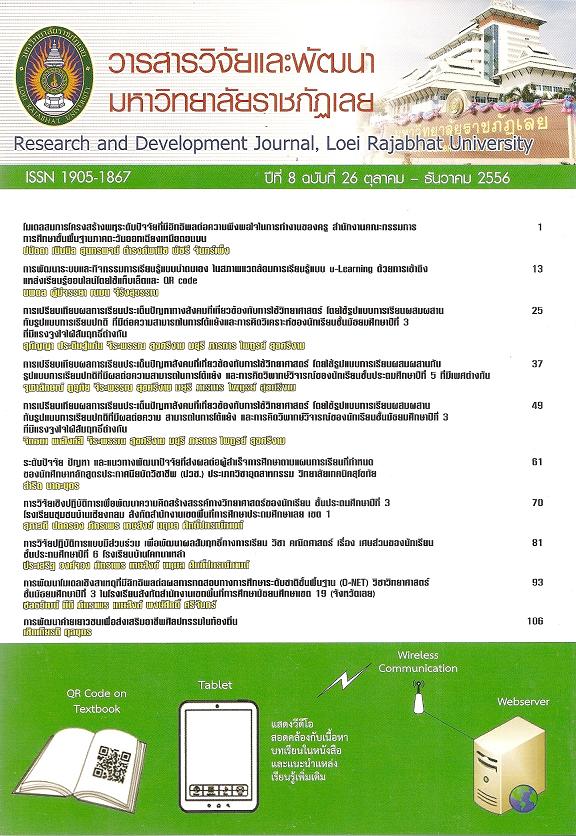การเปรียบเทียบผลการเรียนประเด็นปัญหาสังคมที่เกี่ยวข้องกับการใช้วิทยาศาสตร์ โดยใช้รูปแบบการเรียนผสมผสานกับรูปแบบการเรียนปกติที่มีผลต่อความ สามารถในการโต้แย้ง และการคิดวิพากษ์วิจารณ์ของนักเรียนชั้นมัธยมศึกษาปีที่ 3 ที่มีแรงจูงใจใฝ่สัมฤทธิ์ต่างกัน
Keywords:
ประเด็นปัญหาทางสังคมที่เกี่ยวข้องกับการใช้วิทยาศาสตร์, การโต้แย้ง, การคิดวิพากษ์วิจารณ์การเรียน, แบบผสมผสาน, socioscientific issues, argumentation, critical thinking, mixed method learningAbstract
บทคัดย่อ
การวิจัยครั้งนี้มีจุดมุ่งหมายเพื่อเปรียบเทียบการโต้แย้งและการคิดวิพากษ์วิจารณ์หลังเรียน ประเด็นปัญหาทางสังคมที่เกี่ยวข้องกับการใช้วิทยาศาสตร์ของนักเรียนที่มีแรงจูงใจใฝ่สัมฤทธิ์และเรียนด้วยรูปแบบการเรียนต่างกัน กลุ่มตัวอย่างเป็น นักเรียนชั้นมัธยมศึกษา ปีที่ 3 จำนวน 63 คน ได้มาโดยการสุ่มแบบกลุ่ม แบ่งเป็น 2 กลุ่ม คือ กลุ่มทดลองนักเรียน 32 คน เรียนแบบผสมผสาน และกลุ่มควบคุม นักเรียน 31 คน เรียนแบบปกติ เครื่องมือที่ใช้ในการเก็บรวบรวมข้อมูลประกอบด้วย(1)แผนการจัดการเรียนรู้โดยใช้ประเด็นปัญหาทางสังคมที่เกี่ยวข้องกับการใช้วิทยาศาสตร์ จำนวน 4 แผน คือแผนที่ 1 พืชจีเอ็มโอ แผนที่ 2 การปลูกถ่ายอวัยวะ แผนที่ 3 พลังงานทางเลือก (จากมันสำปะหลัง) แผนที่ 4 การทำแท้ง แต่ละแผนใช้เวลาเรียน 3 ชั่วโมงต่อสัปดาห์(2)แบบทดสอบวัดการโต้แย้ง จำนวน 4 ฉบับ และ(3)แบบทดสอบวัดการคิดวิพากษ์วิจารณ์จำนวน 5 ด้านคือ ด้านการอนุมาน ด้านการยอมรับข้อตกลงเบื้องต้น ด้านการนิรนัย ด้านการตีความ และด้านการประเมินข้อโต้แย้ง จำนวน 30 ข้อ สถิติที่ใช้ทดสอบสมมติฐานคือ Dependent t-test, F-test (Two-way MANCOVA และ Two-way ANCOVA)
ผลการวิจัยพบว่า 1) นักเรียนโดยส่วนรวมและ จำแนกตามแรงจูงใจใฝ่สัมฤทธิ์หลังเรียนโดย ใช้รูปแบบผสมผสาน มีการพัฒนาความสามารถในการโต้แย้งจากการสอบครั้งที่ 1-4 เพิ่มขึ้นตามลำดับ และมีการคิดวิพากษ์วิจารณ์โดยรวมและรายด้านทุกด้าน เพิ่มขึ้นจากก่อนเรียน อย่างมีนัยสำคัญทางสถิติที่ระดับ .05 2) นักเรียนที่มีแรงจูงใจใฝ่สัมฤทธิ์ต่างกัน มีความสามารถในการโต้แย้งไม่แตกต่างกัน (P>.025) แต่นักเรียนที่มีแรงจูงใจใฝ่สัมฤทธิ์สูง มีการคิดวิพากษ์วิจารณ์โดยรวมและรายด้าน จำนวน 4 ด้าน (ยกเว้นด้านอนุมาน)มากกว่านักเรียนที่มีแรงจูงใจใฝ่สัมฤทธิ์ต่ำอย่างมีนัยสำคัญทางสถิติที่ระดับ .05 3)นักเรียนที่เรียนด้วยรูปแบบผสมผสานมีความสามารถในการโต้แย้ง และมีการคิดวิพากษ์วิจารณ์โดยรวมและด้านการประเมินข้อโต้แย้ง มากกว่านักเรียนที่เรียนรูปแบบการเรียนปกติ อย่างมีนัยสำคัญทางสถิติที่ระดับ .025 และ 4)ไม่มีปฏิสัมพันธ์ระหว่างแรงจูงใจใฝ่สัมฤทธิ์และรูปแบบการเรียน ต่อความสามารในการโต้แย้ง และการคิดวิพากษ์วิจารณ์โดยรวม และรายด้านของนักเรียน (P>.05)
Abstract
This research aimed to compare the argumentation and critical thinking abilities after learning the socioscientific issues of the students with different achievement motives and learning methods. The sample consisted of 63 Mathayomsuksa 3 (grade 9) students, obtained using the cluster random sampling technique. These students were assigned to an experimental group with 32 students who learned using the mixed method and a control group with 31 students who learned using the conventional learning method. Instruments employed for the study included (1) lesson plans on socioscientific issues : genetically modified plants, organ transplantation, and alternative energy from cassava, 3 plans for the experimental group and the other 3 plans for the control group, 4 pians aborticide each plan for 3 hours of learning in a week ; (2) four argumentation tests ; and (3) the critical thinking test with 5 subscales: interpretation, deduction, inference, recognition of assumptions, and evaluation of arguments , and with 30 items. The dependent t-test and the F-test (Two-way MANCOVA and ANCOVA) were employed for testing hypotheses.
The major findings revealed that the students as a whole and as classified according to achievement motives who learned the socioscientific issues using the mixed method and the conventional learning method showed developments of argumentation abilities from the 1st test to the 4th test ; and showed gains in critical thinking in general and in each subscale from before learning at the .05 level of significance. (The students with different achievement motives did not indicate argumentation differently (P>025). However, the students with high achievement motives showed argumentation abilities and critical thinking abilities in general and in 4 subscales: (except for the inferrence) more than the students with low achievement motives (p>.05). The experimental group students evidenced more argumentation abilities and critical thinking abilities in general and in the scale of evaluation of arguments than the counterpart students (p >.025). Statistical interactions of achievement motives with learning methods on argumentation and critical thinking abilities in general and in each subscale were not found to be significant. (p>.05)
Downloads
How to Cite
Issue
Section
License
ข้อความที่ปรากฎในวารสารฉบับนี้เป็นความคิดเห็นของผู้เขียนแต่ละท่าน สถาบันวิจัยและพัฒนา มหาวิทยาลัยราชภัฏเลย และกองบรรณาธิการ ไม่จำเป็นต้องเห็นด้วยและไม่มีส่วนรับผิดชอบใดๆ
สถาบันวิจัยและพัฒนา มหาวิทยาลัยราชภัฏเลย ขอให้ผู้อ่านอ้างอิงในกรณีที่ท่านคัดลอกเนื้อหาบทความในวารสารฉบับนี้






